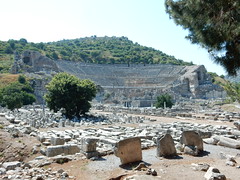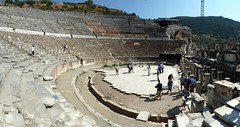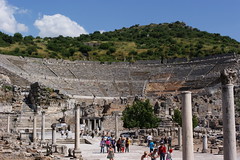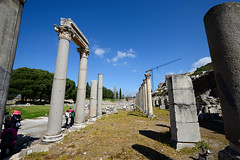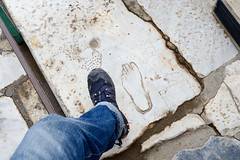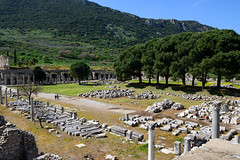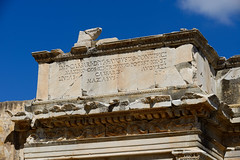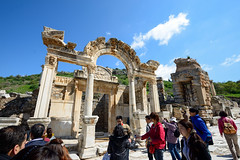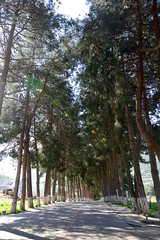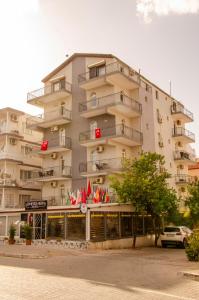Ephesus
Ephesus (English: /ˈɛfɪsəs/; ; Turkish: Efes; may ultimately derive from) was a city in ancient Greece on the coast of Ionia, southwest of present-day Selçuk in İzmir Province, Turkey. It was built in the 10th century BC on the site of Apasa, the former Arzawan capital, by Attic and Ionian Greek colonists. During the Classical Greek era, it was one of twelve cities that were members of the Ionian League. The city came under the control of the Roman Republic in 129 BC.
The city was famous in its day for the nearby Temple of Artemis (completed around 550 BC), which has been designated one of the Seven Wonders of the Ancient World. Its many monumental buildings included the Library of Celsus and a theatre capable of holding 24,000 spectators.
Ephesus was recipient city of one of the Pauline epistles; one of the seven churches of Asia addressed in the Book of Revelation; the Gospel of John may have been written there; and it was the site of several 5th-century Christian Councils (see Council of Ephesus). The city was destroyed by the Goths in 263. Although it was afterwards rebuilt, its importance as a commercial centre declined as the harbour was slowly silted up by the Küçükmenderes River. In 614, it was partially destroyed by an earthquake.
Today, the ruins of Ephesus are a favourite international and local tourist attraction, being accessible from Adnan Menderes Airport and from the resort town Kuşadası. In 2015, the ruins were designated a UNESCO World Heritage Site.
History
Neolithic age
Humans had begun inhabiting the area surrounding Ephesus by the Neolithic Age (about 6000 BC), as shown by evidence from excavations at the nearby höyük (artificial mounds known as tells) of and Cukurici.
Bronze Age
Excavations in recent years have unearthed settlements from the early Bronze Age at Ayasuluk Hill. According to Hittite sources, the capital of the kingdom of Arzawa (another independent state in Western and Southern Anatolia/Asia Minor) was Apasa (or Abasa), and some scholars suggest that this is the same place the Greeks later called Ephesus. In 1954, a burial ground from the Mycenaean era (1500–1400 BC), which contained ceramic pots, was discovered close to the ruins of the basilica of St. John. This was the period of the Mycenaean expansion, when the Ahhiyawa began settling in Asia Minor, a process that continued into the 13th century BC. The names Apasa and Ephesus appear to be cognate, and recently found inscriptions seem to pinpoint the places in the Hittite record.
Period of Greek migrations
Ephesus was founded as an Attic-Ionian colony in the 10th century BC on a hill (now known as the Ayasuluk Hill), three kilometers from the centre of ancient Ephesus (as attested by excavations at the Seljuk castle during the 1990s). The mythical founder of the city was a prince of Athens named Androklos, who had to leave his country after the death of his father, King Kodros. According to the legend, he founded Ephesus on the place where the oracle of Delphi became reality ("A fish and a boar will show you the way"). Androklos drove away most of the native Carian and Lelegian inhabitants of the city and united his people with the remainder. He was a successful warrior, and as a king he was able to join the twelve cities of Ionia together into the Ionian League. During his reign the city began to prosper. He died in a battle against the Carians when he came to the aid of Priene, another city of the Ionian League. Androklos and his dog are depicted on the Hadrian temple frieze, dating from the 2nd century. Later, Greek historians such as Pausanias, Strabo and Herodotos and the poet Kallinos reassigned the city's mythological foundation to Ephos, queen of the Amazons.
The Greek goddess Artemis and the great Anatolian goddess Kybele were identified together as Artemis of Ephesus. The many-breasted "Lady of Ephesus", identified with Artemis, was venerated in the Temple of Artemis, one of the Seven Wonders of the World and the largest building of the ancient world according to Pausanias (4.31.8). Pausanias mentions that the temple was built by Ephesus, son of the river god Caystrus, before the arrival of the Ionians. Of this structure, scarcely a trace remains.
Ancient sources seem to indicate that an older name of the place was Alope .
Archaic period
About 650 BC, Ephesus was attacked by the Cimmerians who razed the city, including the temple of Artemis. After the Cimmerians had been driven away, the city was ruled by a series of tyrants. Following a revolt by the people, Ephesus was ruled by a council. The city prospered again under a new rule, producing a number of important historical figures such as the elegiac poet Callinus and the iambic poet Hipponax, the philosopher Heraclitus, the great painter Parrhasius and later the grammarian Zenodotos and physicians Soranus and Rufus.
About 560 BC, Ephesus was conquered by the Lydians under king Croesus, who, though a harsh ruler, treated the inhabitants with respect and even became the main contributor to the reconstruction of the temple of Artemis. His signature has been found on the base of one of the columns of the temple (now on display in the British Museum). Croesus made the populations of the different settlements around Ephesus regroup (synoikismos) in the vicinity of the Temple of Artemis, enlarging the city.
Later in the same century, the Lydians under Croesus invaded Persia. The Ionians refused a peace offer from Cyrus the Great, siding with the Lydians instead. After the Persians defeated Croesus, the Ionians offered to make peace, but Cyrus insisted that they surrender and become part of the empire. They were defeated by the Persian army commander Harpagos in 547 BC. The Persians then incorporated the Greek cities of Asia Minor into the Achaemenid Empire. Those cities were then ruled by satraps.
Ephesus has intrigued archaeologists because for the Archaic Period there is no definite location for the settlement. There are numerous sites to suggest the movement of a settlement between the Bronze Age and the Roman period, but the silting up of the natural harbours as well as the movement of the Kayster River meant that the location never remained the same.
Classical period
Ephesus continued to prosper, but when taxes were raised under Cambyses II and Darius, the Ephesians participated in the Ionian Revolt against Persian rule in the Battle of Ephesus (498 BC), an event which instigated the Greco-Persian wars. In 479 BC, the Ionians, together with Athens, were able to oust the Persians from the shores of Asia Minor. In 478 BC, the Ionian cities with Athens entered into the Delian League against the Persians. Ephesus did not contribute ships but gave financial support.
During the Peloponnesian War, Ephesus was first allied to Athens but in a later phase, called the Decelean War, or the Ionian War, sided with Sparta, which also had received the support of the Persians. As a result, rule over the cities of Ionia was ceded again to Persia.
These wars did not greatly affect daily life in Ephesus. The Ephesians were surprisingly modern in their social relations: they allowed strangers to integrate and education was valued. In later times, Pliny the Elder mentioned having seen at Ephesus a representation of the goddess Diana by Timarete, the daughter of a painter.
In 356 BC the temple of Artemis was burnt down, according to legend, by a lunatic called Herostratus. The inhabitants of Ephesus at once set about restoring the temple and even planned a larger and grander one than the original.
Hellenistic period
When Alexander the Great defeated the Persian forces at the Battle of Granicus in 334 BC, the Greek cities of Asia Minor were liberated. The pro-Persian tyrant Syrpax and his family were stoned to death, and Alexander was greeted warmly when he entered Ephesus in triumph. When Alexander saw that the temple of Artemis was not yet finished, he proposed to finance it and have his name inscribed on the front. But the inhabitants of Ephesus demurred, claiming that it was not fitting for one god to build a temple to another. After Alexander's death in 323 BC, Ephesus in 290 BC came under the rule of one of Alexander's generals, Lysimachus.
As the river Cayster (Grk. name Κάϋστρος) silted up the old harbour, the resulting marshes caused malaria and many deaths among the inhabitants. Lysimachus forced the people to move from the ancient settlement around the temple of Artemis to the present site two kilometres away, when as a last resort the king flooded the old city by blocking the sewers. The new settlement was officially called Arsinoea (or Ἀρσινοΐα) or Arsinoe (Ἀρσινόη), after the king's second wife, Arsinoe II of Egypt. After Lysimachus had destroyed the nearby cities of Lebedos and Colophon in 292 BC, he relocated their inhabitants to the new city.
Ephesus revolted after the treacherous death of Agathocles, giving the Hellenistic king of Syria and Mesopotamia Seleucus I Nicator an opportunity for removing and killing Lysimachus, his last rival, at the Battle of Corupedium in 281 BC. After the death of Lysimachus the town again was named Ephesus.
Thus Ephesus became part of the Seleucid Empire. After the murder of king Antiochus II Theos and his Egyptian wife, pharaoh Ptolemy III invaded the Seleucid Empire and the Egyptian fleet swept the coast of Asia Minor. Ephesus came under Egyptian rule between 263 and 197 BC.
The Seleucid king Antiochus III the Great tried to regain the Greek cities of Asia Minor and recaptured Ephesus in 196 BC but he then came into conflict with Rome. After a series of battles, he was defeated by Scipio Asiaticus at the Battle of Magnesia in 190 BC. As a result of the subsequent Treaty of Apamea, Ephesus came under the rule of Eumenes II, the Attalid king of Pergamon, (ruled 197–159 BC). When his grandson Attalus III died in 133 BC without male children of his …
Hotels Ephesus
Looking for places related to Ephesus?
Those are other destinations to find places related to Ephesus:
- Ephesus
- Samos
- Priene
- Adnan Menderes Airp…
- Teos
- Library of Celsus
- House of the Virgin…
- Labraunda
- Claros
- İzmir Atatürk Stadi…
- Magnesia on the Mae…
- İsa Bey Mosque
- İzmir Halkapınar Sp…
- Bornova Anadolu Lis…
- Alabanda
- Colophon
- İzmir Clock Tower
- Büyük Menderes River
- Tunnel of Eupalinos
- Klazomenai
- Çamlık Railway Muse…
- Bornova Ice Sports …
- Panionium
- Mycale
![Theatre, Ephesus (Efes, Selçuk), Turkey [DSCN0677]](https://live.staticflickr.com/3839/14727406656_d4a71c7955_z.jpg)
![Theatre, Ephesus (Efes, Selçuk), Turkey [DSCN0677]](https://live.staticflickr.com/3839/14727406656_d4a71c7955_m.jpg)
